In his 'I Believe' essay for the 2019-20 Excellence Diploma, Cheil London's Kiron Mair argues that brands should be more tantric rather than chasing instant gratification.
We live in an over-stimulated society. This is an era of immediate, throwaway consumerism. We’re bombarded with notifications, snackable video, fast fashion & food, and as much content on-demand, whenever we want it, i.e. Now.
This is damaging brands. Our instant gratification culture drives people to demand more and value everything less. We’re neurologically wired to favour immediate rewards, which not only explains consumer demand for instant gratification, it’s propping up a business culture of short-termism that feeds it.
Ultimately, the neuroscience of instant gratification shows that every interaction designed to drive an instant hit has a net negative effect. This results in disposable advertising, an emphasis on performance marketing which creates an experience debt, and a loss of brand value for consumers.
But there is a solution – just ask Sting. Drawing from neuroscience, I propose a model of balance called Tantric Brands – under which brands can be more valuable to consumers, and ensure that all communications and interactions have a net positive effect.
This model is based on three pillars. In order to become tantric, brands must:
- Acknowledge that quickies are good, but alone aren’t enough;
- Understand their partners (customers) more intimately;
- Then spice up the (brand) experience
By following the steps, they and their partners can have more sustainably fulfilling relationships.
Introduction
Humans have excelled over other primates for many reasons - most importantly the physiology of our brains.
One element is our larger prefrontal cortex, which is responsible for impulse management, amongst other functions (Smaers et al, 2017).
While all species are instinctively driven to favour immediate reward, what separates us is our greater ability to strike a balance between indulging and managing our impulses.
However, artificial stimuli in the modern world tips this balance.
Supernormal stimuli
Evolutionary biologists use the term 'supernormal stimuli' to describe any stimulus that elicits a response greater than its biological imperative.
Ethologist Nikolas Tinbergen created supernormal stimuli by presenting fluorescent plastic eggs to birds, alongside real eggs.
The birds were more attracted to the fluorescent eggs than their own, demonstrating that the artificial stimuli overpowered their natural instincts (Barret, 2010).
Sources of gratification such as fast food, push notifications and social media are supernormal stimuli. Designed to elicit intense reactions and seeking behaviours, these stimuli provide quick hits over healthy benefits.
In this sense, instant gratification has been packaged for us since the early 20th century welcomed brands like McDonald's.
Instant fulfillment
Perhaps no brand is more culpable for instant gratification than Amazon Prime.
Offering as quick as 1 hour delivery, Amazon Prime has accelerated consumer demand for instant delivery since it was trialed in 2013, with 40% of consumers in the UK now demanding same day or next day delivery (Rama, 2019). The word 'fulfilment' in today’s world belongs to couriers and logistics companies.
The more brands cater for immediacy, the more consumers’ loyalty is contingent on it. 45% of consumers will change brands if their needs aren’t actively anticipated (Hartmuth, 2019).
Throwaway content, throwaway things
The demand for immediacy has also informed a culture in which content is shorter and more abundant; our collective attention span has narrowed significantly over the past 25 years (Lorenz-Spreen et al., 2019).
The rise of fast-moving, disposable content platforms like Snapchat and TikTok mirror the smartphone market, in which brands are both the drivers and beneficiaries of this culture (Eadicco, 2020).
Smartphone manufacturers operate on an annual release cycle, driving demand only for their latest model, leaving old models to be strategically obsolete within two years (Gibbs, 2018).
Rather than being enduringly useful, our closest personal devices are quickly discarded and replaced. There’s a clear parallel between our psychology towards things, and towards content.
Brands impact culture; culture impacts brands
Marketers' behaviour and the culture in which we operate is a reflection of our accelerated desires.
In surveying marketers industry-wide via online questionnaire, 85% expressed a desire to make work that is meaningful to society. However, our individual reflexes inform the markets we work into, and vice versa (Roberts, 2015).
We as consumers seek more instant gratification and we as marketers move to meet this need.
But it’s not just catering to demand – we’re driven by the ‘instant gratification’ of immediate sales
over longer term brand growth.
As a result, we've created a business culture that mandates this through shareholders' quarterly earnings reports, incentive structuring and short CMO tenures, all measured in immediate sales impact rather than brand value appreciation (Price, 2017).
But at what cost?
The research of Binet and Field has illustrated that short-termism, whilst driving efficiency, does not support the 'very large business effects' required for long-term growth, including profit, market share and reduced price sensitivity (Binet and Field, 2013).
The impact of short-termism and the 'disposable advertising' it creates is that even creatively awarded campaigns are now less effective than ever; the average number of very large business effects reported is the lowest in 25 years. Moreover, creatively awarded short-term campaigns are actually 25% less effective than non-awarded campaigns (Field, 2019).
While these results are troubling, what matters more is that, as a result of this shift towards disposable communications, brands are now valued less by consumers than they’ve ever been.
Havas’ Meaningful Brands (2017) found that 60% of content created by the top 1,500 brands is seen by consumers as 'irrelevant' or 'clutter'.
The focus on digital touchpoints and performance metrics has created an 'experience debt' in which consumers are valuing their interactions with brands less, as their deeper human needs are not being met (O’Brien et al, 2019).
Ultimately, consumers wouldn’t care if 81% of brands ceased to exist (Rogers, 2019).
If the perils of short-termism are well documented, brand content is viewed as disposable, brands are less valued, but we’re wired to favour immediate reward, what hope is there for change?
The answer lies in the physiology of our brains.

The dopamine myth
The driving force of instant gratification is dopamine.
Dopamine is well documented in popular media as 'the pleasure chemical, but this is a misnomer.
It is the neurotransmitter produced in the limbic system (specifically the ‘reward system’) in response to instantly gratifying stimuli, however its primary effect is driving seeking behaviour rather than a pleasure response (Adinoff, 2004).
This was demonstrated in gamblers who lost money on a near miss – activity in their 'pleasure centre' was as strong as when they won (Chase and Clark, 2010). Thus, a more pertinent term might be the 'wanting system'.
Seeking vs satisfaction
Another neurotransmitter that mediates behaviour is serotonin. This signals satisfaction and contributes to feelings of wellbeing as a result of activities like exercising, family time or others that promote self-affirmation (Young, 2007).
Serotonin has an inverse relationship with dopamine. When dopamine increases, serotonin decreases. In other words, the more we seek, the less satisfied we are (Moran et al, 2018).
This fact is key to highlighting that every brand action that is designed to create an instant hit or response has a net unsatisfying effect.
So why are the two regions important?
The limbic system is involved in instant gratification via the circulation of dopamine.
The PFC is engaged when we choose the future reward instead of the immediate reward, or make value judgements on desires – in other words, delaying gratification (McClure et al, 2004).
Serotonin fuels the PFC (Puig and Gulledge, 2011).
In other words, the more satisfied and self-affirmed we are, the easier it is for us to make considered choices that delay gratification and place higher value on things.
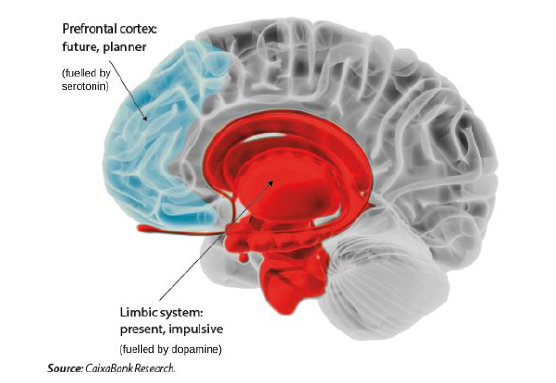
Where do brands come into this?
Every action designed to create an instant hit has a net unsatisfying effect. This explains why short-term, disposable advertising damages value for consumers as well as reducing brand effectiveness.
Performance tactics are the prime example of instant gratification for both marketers and consumers, incorporating promotions and time-specific calls to action. Equally, advertising designed to generate immediate attention during the campaign only, without enduring emotional value, has a similarly negative effect.
They invite consumers to consider the brand only in the context of buying now and the 'reward' associated with buying, thus tap into unsatisfying seeking behaviours that aren’t valued.
It’s important to acknowledge that ‘increased satisfaction’ alone will not suffice.
Experience debt is also contributing to the loss of brand value, as a result of human needs not being met by the increased dependence on digital touchpoints and performance metrics.
This means serotonin is not the sole hero. Fulfilment (the resulting state of these deeper needs being met), otherwise known as hedonic balance, is reached through a combination of neurotransmitters that include serotonin, dopamine and others like oxytocin. The key is balance (Kringelbach and Berridge, 2010).
Therefore, if instant gratification is the enemy of brands, then I believe the hero to be 'sustainable fulfilment'.
What does 'sustainable fulfilment' mean for brands?
Sustainable means enduring, self-supporting and maintainable. It is the ability to frame decisions in terms of years rather than the next campaign or quarterly earnings report (Grant, 2020).
Fulfilment, rather than courier-speak, means holistic engagement with consumers that gives them value beyond just putting a product in their hands.
By providing a balance of instant and delayed gratification, meeting customers’ higher needs and building a richer brand experience, brands can offer the sustainable fulfilment that customers need in order to build more valued relationships with them.
Tantric Brands
This is where I nod to Sting for introducing Tantric Brands.
Tantric Brands are built on three pillars. In order to become tantric, brands must:
- Acknowledge that quickies are good, but alone aren’t enough (balancing instant and
delayed gratification). - Understand their partners more intimately (understand their customers’ deeper human
needs and values) - Then spice up the experience (develop a more engaging brand experience that caters to
the senses, builds community and physical interactions)
1. Quickies are good, but alone aren’t enough: A move from instant gratification to intertemporal gratification
Everyone enjoys a quick fumble. In the same way, short-term marketing tactics are proven to be cost efficient, and drive sales and mental availability (Sharp, 2016).
However, quickies aren’t the basis of a fulfilling relationship. Sometimes you need to take your time.
It’s important to distinguish brands from products. A brand may exist in a 'fast' product category selling consumable goods with a short lifespan – but have a 'slow' brand persona that has established emotional resonance with consumers. Equally a brand may sell a 'slow' product with a longer lifespan but have a 'fast' brand persona that leans into promotions and performance marketing.

There are many cautionary tales of 'fast brands' such as the slipper brand Mahabis, who went into administration after an over-reliance on the instant gratification of digital performance marketing tactics not only left it unable to complete orders, but also damaged its reputation (Huntington, 2019).
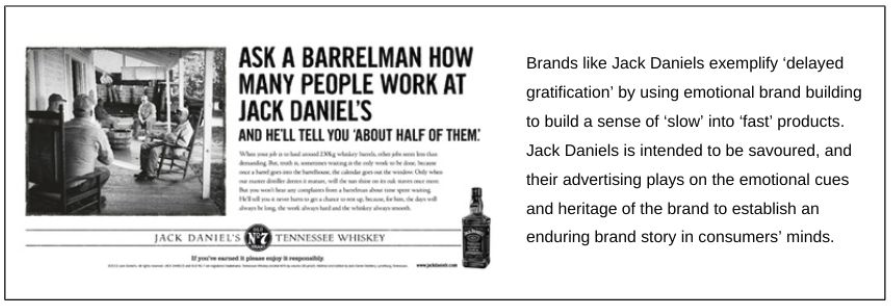
Just as quickies on their own aren’t enough, solely prolonged sessions aren’t sustainable!
What is required is balance (intertemporal gratification), as supported by the 60:40 rule of brand building vs activation, and its permutations for different categories that applied correctly result in greater effectiveness (Binet and Field, 2019). This relies on both message and medium, as a balance of paid, owned and earned media is needed including proven brand building channels like TV (Binet and Field, 2017).
Communications should be centred around an element that will be enduring beyond the campaign. Think about the best brands that create personas or cues as part of a consistent ongoing story, like Old Spice; their communications showcase more than just product messages, they build on past campaigns and encode emotional memory structures (Schacter, 2000).
Intertemporal gratification applied
Let’s take the unsexy category of biros; as sales trainers implore, "sell me this pen'". Paper Mate is an established manufacturer, however doesn’t feature in the top ten brands for market share and has no emotional brand positioning (Marketwatch, 2019).
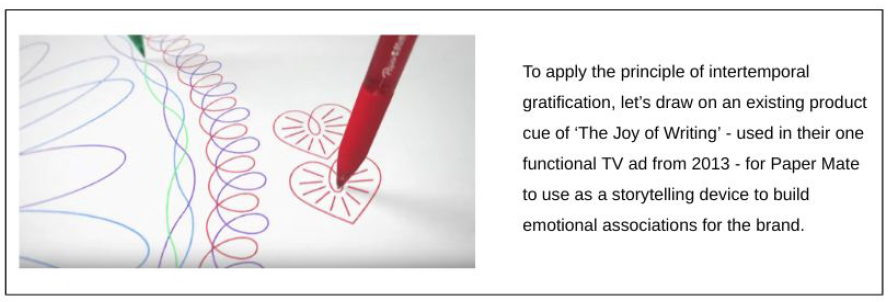
With the durables category balance of 69:31 (Binet and Field, 2019), Paper Mate should spend 69% of budget establishing the Joy of Writing story emotionally through TV and VOD, depicting the feelings the brand conjures up. 31% can be devoted to activating the latest product lines through digital and performance media, but also reinforcing the emotional cues in these communications.
Through the intertemporal approach, Paper Mate starts to build a more 'delayed' and enduring emotional presence in consumers’ minds, whilst still being immediately available to them through sales tactics.
2. Intimate understanding – Meet people’s higher order needs, not just their base wants
Tantric practice is all about being in touch with your partner’s needs, maximising intimacy for a deeper connection.
In the same way, brands should think about how they address the needs of their customers in order to build more fulfilling attachments with them.
Deloitte’s Values Compass (O’Brien, 2019) expresses these as Ambition, Curiosity, Belonging and Control.
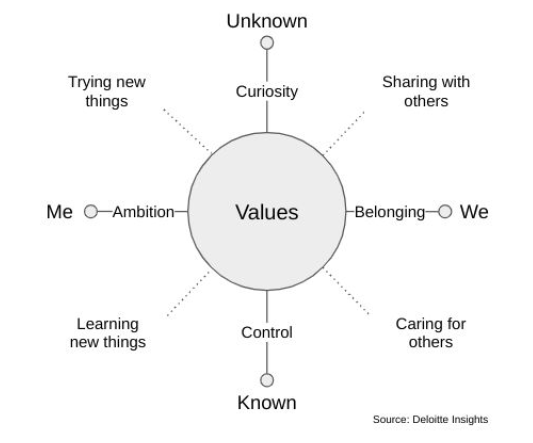
How brands can map their customers’ values
Brands can unearth customers’ values by taking on a human-centred design approach. This is about putting people’s needs at the heart of comms design, and getting there through collaboration, empathy and experimentation (Brown, 2019).
This requires leadership to foster a culture of empathy and innovation and assemble diverse groups of interdisciplinary teams that include focus groups of customers, in order to understand the brand’s overlap with their needs (Bartlett, 2018).
By elevating these needs in their communications and experiences, brands are twice as likely to outperform competitors in revenue growth over three years (O’Brien et al, 2019).
Intimate understanding applied
In order to better understand their customers, Paper Mate must empathise by thinking of their underlying needs – why would they need a great pen? A human centred design process would help them get there – but broadly The Joy of Writing speaks to the personal values of Ambition and Curiosity; trying new things and sharing with others.
This establishes a basis for further emotional campaigns around these values, positioning Paper Mate as an 'Enabler of Dreams' or a 'Creator of Magic', instantly separating from basic ballpoint pen commodities and opening up possibilities for product development.
3. Spice up the experience – move from gratifying things to satisfying experiences
So you’ve identified a need to move things to the next level – you’re trying to take your time a bit more, and you’re building a more intimate connection with your partner. Now you can focus on making the experience a bit more playful or exciting.
Neuroscience shows that experiences are more valuable to consumers than things; they are more likely to create moments of positive valuation and self-affirmation, thus promoting the circulation of serotonin (Young, 2007).
Additionally, customers who have the best brand experiences spend 140% more than those who have the poorest experiences, and show better brand recall (Kriss, 2014).
Positive brand experiences lack tangibility but customers value them more highly because they remain there in their memory. Therefore brands should think about how they “ing their thing” in order to set themselves apart from competitors that provide mere commodities or goods (Pine and Gilmore, 2011).
All businesses can be 'inged' by embedding their offering in an experiential brand that 'sensorialises' it, then promotes community around them, and stages physical interactions with the brand.
Spice up the experience, applied

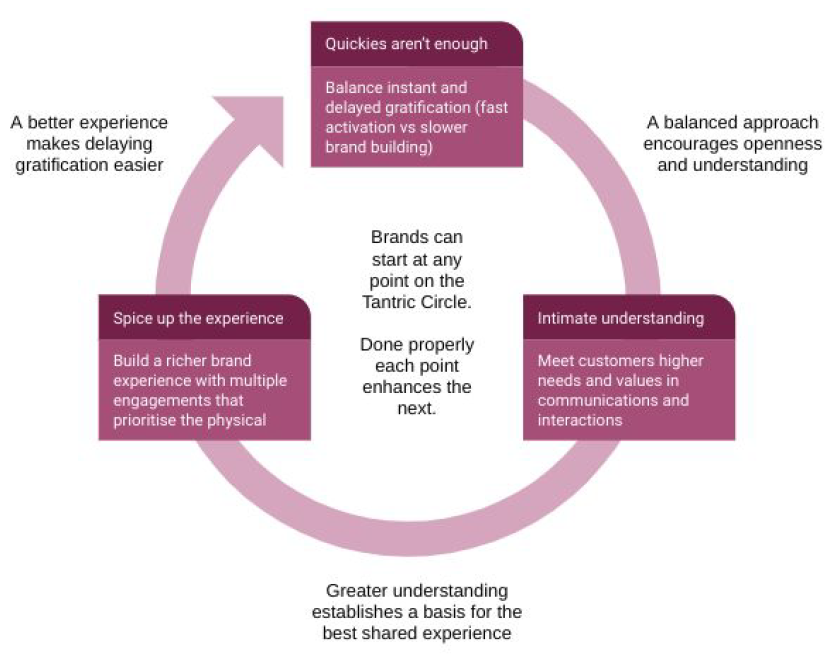
Paper Mate could establish a more valuable, fulfilling place in the minds of consumers. It would just take a bit of practice, starting small, at any point on the Tantric Circle above.
They would build on The Joy of Writing with intertemporally gratifying communications, leverage this to meet their customers’ personal values, and create a multi-dimensional experience around it.
Every brand interaction would therefore have a net positive effect for consumers, and they would become a Tantric Brand.

Conclusion
You might look at Sting’s sexual practice with a sideways glance and a smirk. And it’s true, not everyone needs (or wants) to engage in 7 hour lovemaking sessions. But equally, a life of quickies without any true intimacy or exploration would be transactional and unfulfilling.
While brands can profit solely by pushing products to customers, they won’t grow, or create value – they will just be contributors to the enduring problem of instant gratification, creating a net negative effect and remaining disposable.
By balancing short-term tactics with brand building that establishes a story in the minds of consumers, being self-affirming and meeting their higher needs, and creating multi dimensional interactions, brands will have a net positive effect, pay the experience debt, and become Tantric.
Kiron Mair is a Senior Strategist at Cheil London. This essay earned a distinction as a part of the IPA Excellence Diploma. The 2026 IPA Excellence Diploma in Brands is now open for applications.
View the full syllabus and submit your applicationThe opinions expressed here are those of the authors and were submitted in accordance with the IPA terms and conditions regarding the uploading and contribution of content to the IPA newsletters, IPA website, or other IPA media, and should not be interpreted as representing the opinion of the IPA.